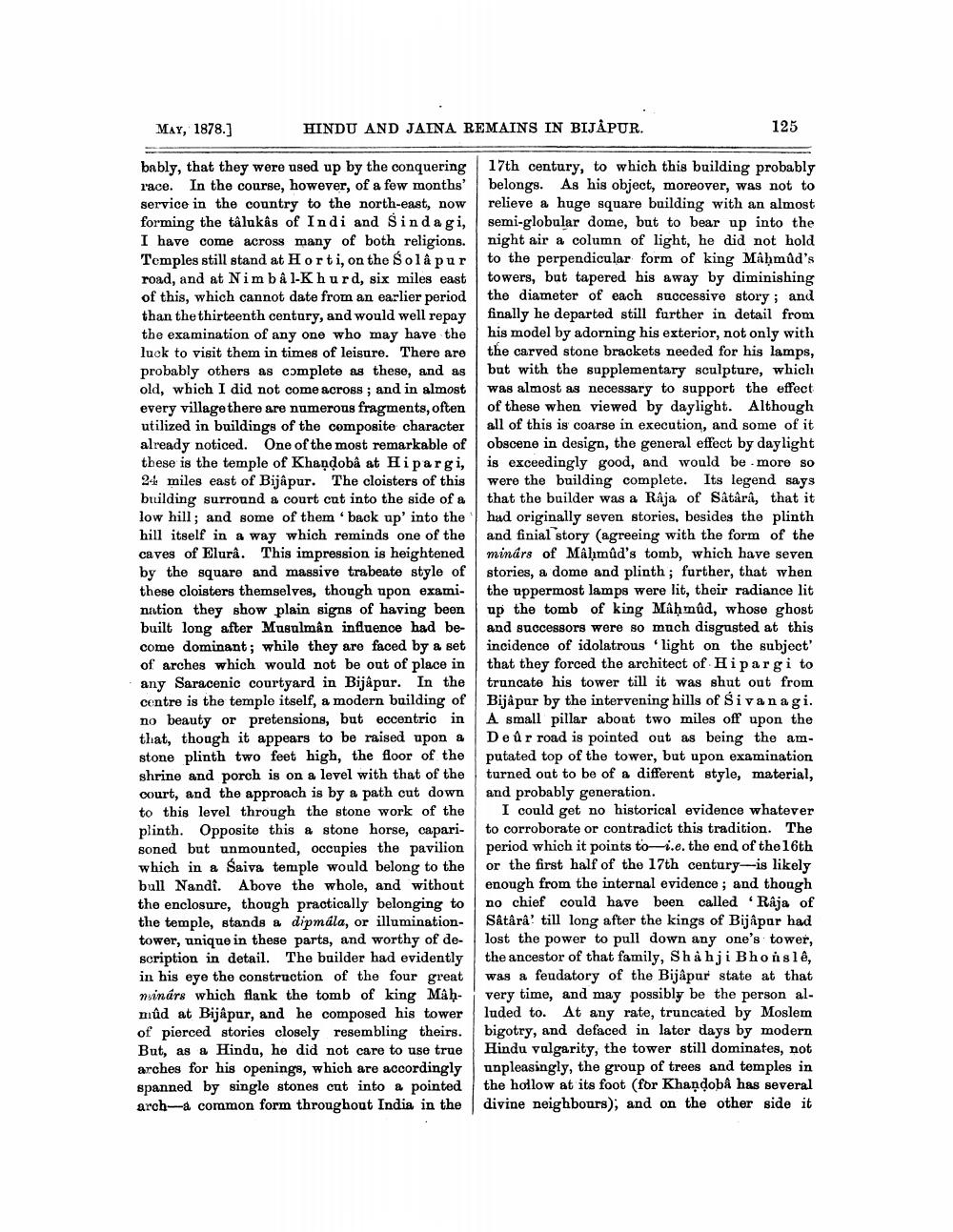________________
MAY, 1878.]
HINDU AND JAINA REMAINS IN BIJAPUR.
125
bably, that they were used up by the conquering 17th century, to which this building probably race. In the course, however, of a few months belongs. As his object, moreover, was not to service in the country to the north-east, now relieve a huge square building with an almost forming the tâlukâs of Indi and Sindagi, semi-globular dome, but to bear up into the I have come across many of both religions. night air a column of light, he did not hold Temples still stand at Horti, on the Solapur to the perpendicular form of king Mahmûd's road, and at Nim ba l-Khurd, six miles east towers, but tapered his away by diminishing of this, which cannot date from an earlier period the diameter of each successive story; and than the thirteenth century, and would well repay finally he departed still further in detail from the examination of any one who may have the his model by adorning his exterior, not only with luck to visit them in times of leisure. There are the carved stone brackets needed for his lamps, probably others as complete as these, and as but with the supplementary sculpture, which old, which I did not come across; and in almost was almost as necessary to support the effect every village there are numerous fragments, often of these when viewed by daylight. Although utilized in buildings of the composite character all of this is coarse in execution, and some of it already noticed. One of the most remarkable of obscene in design, the general effect by daylight these is the temple of Khandobâ at Hipargi, is exceedingly good, and would be more so 24 miles east of Bijapur. The cloisters of this were the building complete. Its legend says building surround a court cut into the side of a that the builder was a Raja of Satara, that it low hill; and some of them back up' into the had originally seven stories, besides the plinth hill itself in a way which reminds one of the and finial story (agreeing with the form of the caves of Elurâ. This impression is heightened minárs of Mahmûd's tomb, which have seven by the square and massive trabeate style of | stories, a dome and plinth; further, that when these cloisters themselves, though upon exami- | the uppermost lamps were lit, their radiance lit nation they show plain signs of having been up the tomb of king Mahmûd, whose ghost built long after Musulman influence had be- and successors were so much disgusted at this come dominant; while they are faced by a set incidence of idolatrous 'light on the subject' of arches which would not be out of place in that they forced the architect of Hipargi to any Saracenic courtyard in Bijapur. In the truncate his tower till it was shut out from centre is the temple itself, a modern building of Bijapur by the intervening hills of Sivanagi. no beauty or pretensions, but eccentric in A small pillar about two miles off upon the that, though it appears to be raised upon a De û r road is pointed out as being the amstone plinth two feet high, the floor of the putated top of the tower, but upon examination shrine and porch is on a level with that of the turned out to be of a different style, material, court, and the approach is by a path cut down and probably generation. to this level through the stone work of the I could get no historical evidence whatever plinth. Opposite this a stone horse, capari- to corroborate or contradict this tradition. The soned but unmounted, occupies the pavilion period which it points to i.e. the end of the 16th which in a Saiva temple would belong to the or the first half of the 17th century-is likely bull Nandt. Above the whole, and without enough from the internal evidence; and though the enclosure, though practically belonging to no chief could have been called 'Raja of the temple, stands a dipmála, or illumination- Satârâ till long after the kings of Bijapur had tower, unique in these parts, and worthy of de- lost the power to pull down any one's tower, scription in detail. The builder had evidently the ancestor of that family, Shahji Bhonsle, in his eye the construction of the four great was a feudatory of the Bijapur state at that ninárs which flank the tomb of king Mah- very time, and may possibly be the person almûd at Bijapur, and he composed his tower luded to. At any rate, truncated by Moslem of pierced stories closely resembling theirs. bigotry, and defaced in later days by modern But, as a Hindu, he did not care to use true Hindu valgarity, the tower still dominates, not arches for his openings, which are accordingly unpleasingly, the group of trees and temples in spanned by single stones cut into a pointed the hollow at its foot (for Khandoba has several arch-a common form throughout India in the divine neighbours); and on the other side it




